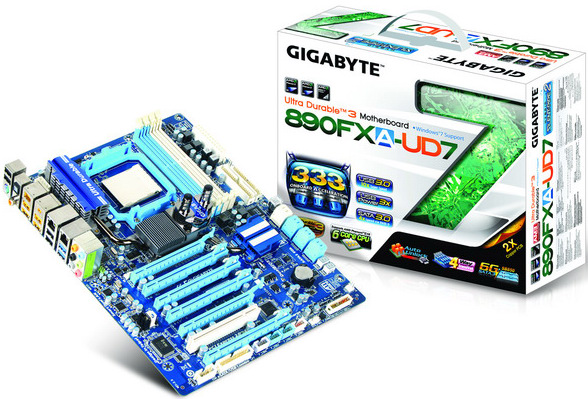Gigabyte GA-890FXA-UD7 Motherboard
|
As for the cooling system, the most noticeable feature is probably the liquid-cooled chipset heatsink. Not that we haven't seen these before (see Intel X38-based motherboards, for example), but it's still unusual. Fortunately, it doesn't mean the AMD 890FX chipset is so hot that it requires liquid cooling. As a matter of fact, the TDP of AMD 890FX is lower than that of AMD 890GX. That's only logical, because the former doesn't feature an integrated graphics core. The exact values are 18W vs. 22W under peak load (both chips consume about 1-2W in standby). So, the liquid cooling feature is primarily intended to attract enthusiasts. By the way, those who actually use liquid cooling will be able to add the chipset heatsink to the cooling circuit. A typical liquid cooling system is too powerful for just a graphics card or a CPU anyway. Besides, this may add stability during overclocking, especially by means of reference frequency.

Perhaps, the only thing that prevents motherboard makers from installing liquid-cooled heatsinks onto all motherboards is that liquid cooling systems are not very widespread, even among enthusiasts. Meaning that such heatsinks will be useless to most people. To please this majority of users, Gigabyte supplies GA-890FXA-UD7 with an "expansion card" shown below.

Obviously, this heatsink may even cool down some energy-efficient CPU, not just a chipset heatsink. So if you're into noiseless cooling, you should be pleased. By the way, only used this thing in overclocking tests. The rest of the time, hexacore CPU tests included, the motherboard worked in its "hottest" mode -- with the liquid-cooled heatsink and no actual liquid cooling. Together with tests of all CPUs needed for comparisons, this is equal to a week of 24/7 operation under an almost peak load. Also note that the body of Cooler Master Hyper Z600 we used overhung the chipset heatsink, probably interfering with convection. So, considering all of the above, the temperature of the chipset heatsink was about 45°C, and the machine was completely stable. Using the Silent-Pipe would've probably lowered the temperature down to the ambient.

The CPU VRM has 10 lanes with 2 highly efficient Low RDS (on) MOSFETs per lane and ferrite chokes. There are 12 x 820µF and 4 x 270µF capacitors, all Japanese and solid. The motherboard also has twice as thicker power and grounding layers. Supported CPUs include models with up to 140W TDP. This is actually Gigabyte's standard set that can also be found on mid-end motherboards. But new hexacore CPUs have 125W TDP anyway. Besides, older 140W CPUs have already had their steppings changed, so all processors AMD ships these days should theoretically consume up to 125W.
Write a comment below. No registration needed!
|
|
 |
|
|
|



